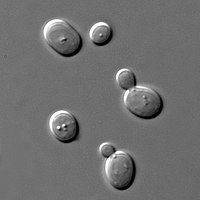
Photo from wikipedia
Background: Sporotrichosis is a subcutaneous mycosis with worldwide distribution and caused by seven pathogenic species of Sporothrix genus: S. schenckii sensu stricto, S. brasiliensis, S. globosa and S. luriei (clinical… Click to show full abstract
Background: Sporotrichosis is a subcutaneous mycosis with worldwide distribution and caused by seven pathogenic species of Sporothrix genus: S. schenckii sensu stricto, S. brasiliensis, S. globosa and S. luriei (clinical clade), and the species S. mexicana, S. pallida and S. chilensis (environmental clade). Isolates of the same species of Sporothrix may have different pathogenicities; however, few isolates of this fungus have been studied. Thus, the aim of this work was to analyze the clinical and anatomopathological changes in immunocompetent and immunosuppressed BALB/c mice infected with clinical and environmental isolates of seven different species of Sporothrix, from both clades. One human clinical isolate of S. schenckii sensu stricto, S. brasiliensis, S. globosa, S. luriei, S. mexicana and S. chilensis species and one environmental isolate of S. pallida were inoculated subcutaneously in immunocompetent mice and the same isolates of S. brasiliensis and S. schenckii sensu stricto were inoculated in immunossupressed mice. Clinical manifestations as external lesions, apathy, and alopecia were observed. At 21, 35, and 49 days after fungal inoculation, four mice from each group were weighed, euthanized and necropsied for evaluation of splenic index, recovery of fungal cells, macroscopic and histopathological analysis of livers, lungs, kidneys, and hearts. The survival assessment was observed for 50 days following inoculation. Our results demonstrated that, clinical S. schenckii isolate, followed by clinical S. mexicana, and environmental S. pallida isolates, the last two, species grouped in the environmental clade, were capable of inducing greater anatomopathological changes in mice, which was reflected in the severity of the clinical signs of these animals. Thus, we reinforce the hypothesis that the pathogenicity of Sporothrix is not only related to the species of this fungus, but also shows variation between different isolates of the same species.
Journal Title: Pathogens
Year Published: 2021
Link to full text (if available)
Share on Social Media: Sign Up to like & get
recommendations!